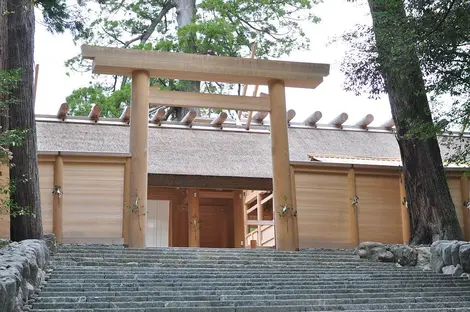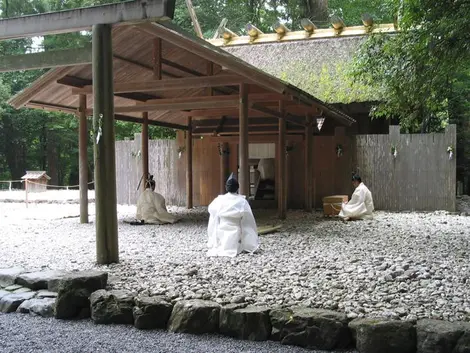The Naiku Shrine 内宮
The holy of holies
Officially called kôtai jingu , the inner sanctuary is imbued with a mystical atmosphere that culminates in climbing the steps leading to the Shôden pavilion...
Once passed the Uji bashi bridge and the great torii, one progresses through a dense forest, on a gravel road, and enters what remains the most sacred area of Japan : the inner Ise shrine - or Naikû - where the goddess Amaterasu is honored (and fed).
It is frequent here to meet high Shinto dignitaries, and like them, you will have to go and purify yourself at the ablution pavilion (the Misogi-kan, but be careful: on the left the basin is reserved for priests, and on the right the Temizusha is open to all visitors) before continuing.
Permission to dream
Beyond, the forest populated by cedars and kami (gods) shelters many secondary temples. The Kazahinomi no miya for example, dedicated to the god of wind, or the Aramatsuri no miya , which allows you to admire closely this shinmei architecture , rare and typical of Ise, of which one will see only a few elements when approaching the Shôden.
It is there, at the top of stairs, that one reaches the Holy of Holies. Or rather that we glimpse it, because no visitor is allowed beyond the entrance of this sanctuary, which is also the official residence of the sun goddess. It is forbidden to take pictures of the buildings as well as the officiants. But it is allowed to dream, to imagine the secret ceremonies which take place daily, the centuries-old rituals which are perpetuated here.
Ancient rice granary
This Shôden is destroyed then rebuilt every 20 years, according to a unique architectural model called shinmei zukuri . While most Shinto shrines in the country post-date the arrival of Buddhism in Japan (4th century) and are inspired by the style of Chinese temples, the main pavilion in Ise is built on the model of the ancient rice granaries of Japan: a raised floor, a gable roof whose beams extend, forming a "v", and a thatched roof.
The Shôden is highly sacred and houses the Yata no kagami mirror , one of the three imperial emblems along with the Magatama jewel (at the Tokyo Imperial Palace) and the Kusanagi sword (at the Atsuta-jinja in Nagoya ).
Address, timetable & access
Address
Price
free admissionAccess
open daily from sunrise to sunset.





















